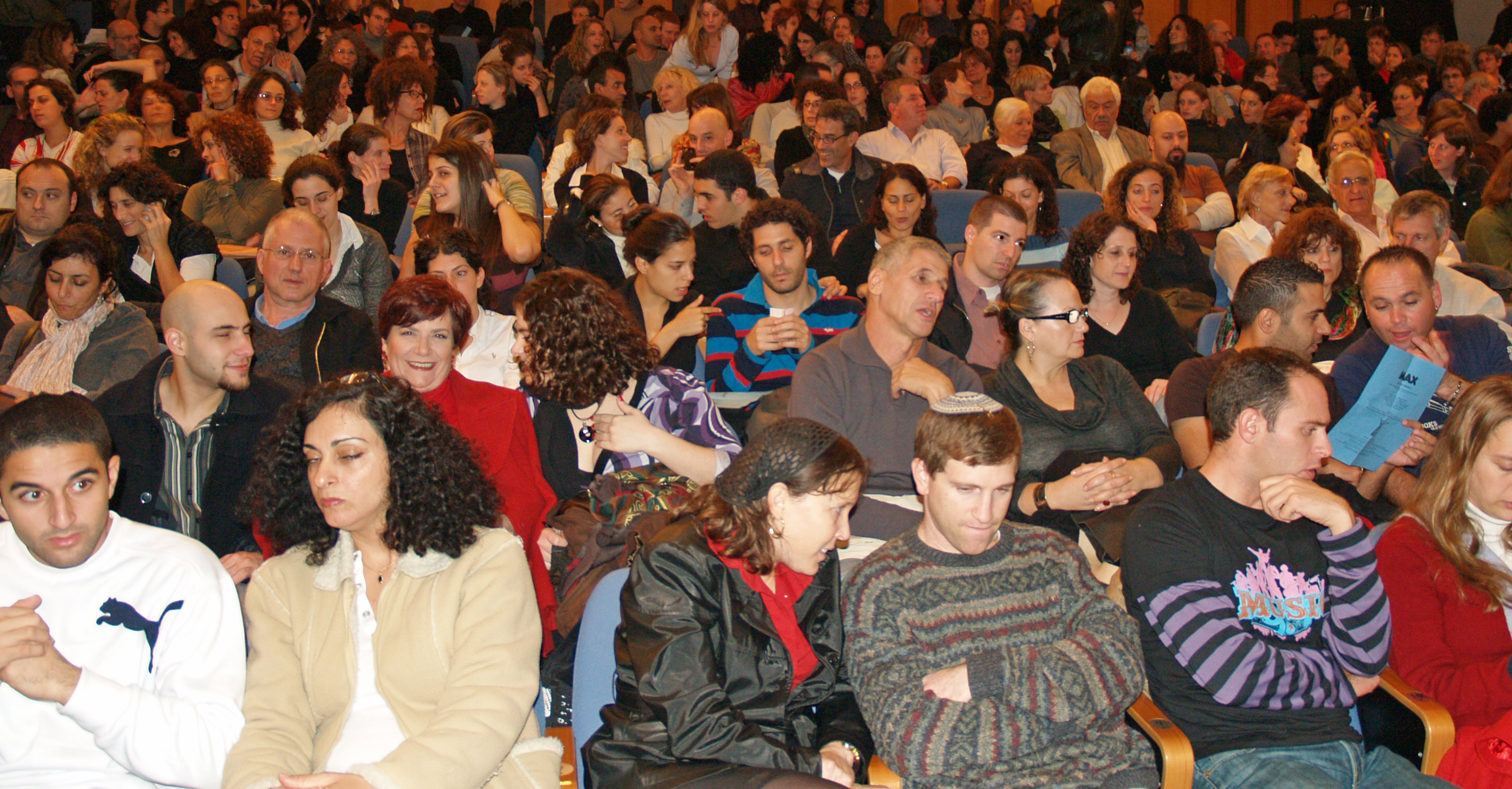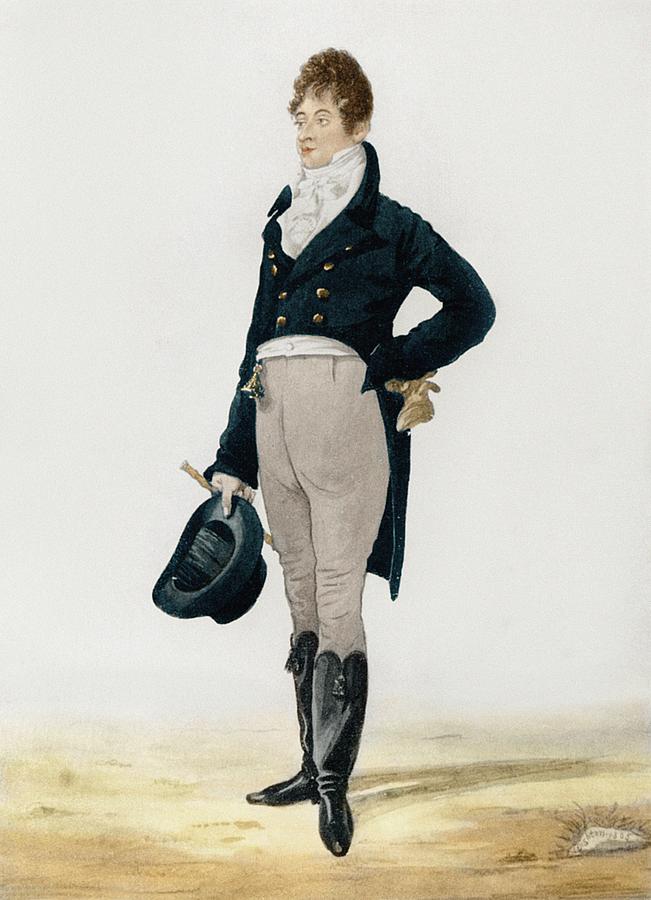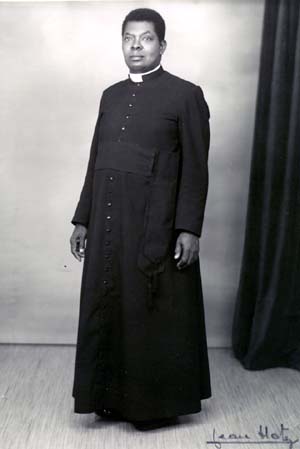|
Redingote
A frock coat is a formal men's coat characterised by a knee-length skirt cut all around the base just above the knee, popular during the Victorian and Edwardian periods (1830s–1910s). It is a fitted, long-sleeved coat with a centre vent at the back and some features unusual in post-Victorian dress. These include the reverse collar and lapels, where the outer edge of the lapel is often cut from a separate piece of cloth from the main body and also a high degree of waist suppression around the waistcoat, where the coat's diameter around the waist is less than around the chest. This is achieved by a high horizontal waist seam with side bodies, which are extra panels of fabric above the waist used to pull in the naturally cylindrical drape. As was usual with all coats in the 19th century, shoulder padding was rare or minimal. In the Age of Revolution around the end of the 18th century, men abandoned the justaucorps with tricorne hats for the directoire style: dress coat with ... [...More Info...] [...Related Items...] OR: [Wikipedia] [Google] [Baidu] |
Coat (clothing)
A coat is typically an outer clothing, garment for the upper body, worn by any gender for warmth or fashion. Coats typically have long sleeves and are open down the front, and closing by means of Button (clothing), buttons, zippers, Hook-and-loop fastener, hook-and-loop fasteners (AKA velcro), toggles, a belt (clothing), belt, or a combination of some of these. Other possible features include Collar (clothing), collars, shoulder straps, and hood (headgear), hoods. Etymology ''Coat'' is one of the earliest clothing category words in English language, English, attested as far back as the early Middle Ages. (''See also'' Clothing terminology.) The Oxford English Dictionary traces ''coat'' in its modern meaning to , when it was written ''cote'' or ''cotte''. The word coat stems from Old French and then Latin ''cottus.'' It originates from the Proto-Indo-European language, Proto-Indo-European word for woolen clothes. An early use of ''coat'' in English is Mail (armour), coat of mai ... [...More Info...] [...Related Items...] OR: [Wikipedia] [Google] [Baidu] |
Frock Coat April 1904
Frock has been used since Middle English as the name for an article of clothing, typically coat-like, for men and women. Terminology In British English and in Commonwealth countries the word may be used as an alternative term for a girl's or woman's dress, in particular for a dress suitable for a smart occasion but (in UK English usage) with a hemline higher than a full-length ballgown. In Australia it is frequently used this way, with the phrase "to frock up" meaning to wear a formal dress or gown for a special occasion. Relatedly, a frock coat is a men's coat style of the 19th century, characterized by full skirts reaching to the lower thigh or knee. Despite the similarity in the name, the frock coat should be regarded as being a distinct garment quite separate from the frock. In the French language the frock coat is called (from English "riding coat"), and so, unlike the English term, implies no immediate relationship to the frock which is called . Indeed, the modern Frenc ... [...More Info...] [...Related Items...] OR: [Wikipedia] [Google] [Baidu] |
Single-breasted
A single-breasted garment is a coat, jacket, vest, or similar item having one column of buttons and a narrow overlap of fabric. In contrast, a double-breasted coat has a wider overlap and two parallel rows of buttons. Single-breasted suit jackets and blazers typically have two or three buttons (jackets with one or four buttons are less common), and a notch lapel. However, from the 1930s onwards, peaked lapels on a single button jacket have been variably in fashion. The width of the lapels is one of the most changeable aspects of the jacket, and narrow peak lapels on single-breasted jackets became popular during the 2000s. Historically, the single-breasted jacket was worn by the ground troops: it was easier to mount a horse with the fronts spreading out to the sides. The back of the jacket also had one slit for ease of dressage. Those who were especially enterprising even cut the floors in the front, and so appeared a modern tailcoat. Buttons on a single-breasted jacket cou ... [...More Info...] [...Related Items...] OR: [Wikipedia] [Google] [Baidu] |
British Royal Court
The Court of St James's serves as the official royal court for the Sovereign of the United Kingdom. The court formally receives all ambassadors accredited to the United Kingdom. Likewise, ambassadors representing the United Kingdom are formally accredited from this court. The Marshal of the Diplomatic Corps, known as Master of the Ceremonies before 1920, serves as the liaison between the British monarch and foreign diplomatic missions. The Marshal is stationed permanently at St James's Palace. As of 1886, there were merely six ambassadors in London, while 37 other countries were represented by ministers. (The custom, developed in the 18th century, was that only monarchies sent ambassadors, while others sent ministers; this distinction was abrogated toward the end of the 19th century.) By 2015, the number of foreign missions accredited to the Court of St James's had risen to 175, including 47 high commissions from Commonwealth countries and 128 embassies from non-Commonwealth coun ... [...More Info...] [...Related Items...] OR: [Wikipedia] [Google] [Baidu] |
Audience
An audience is a group of people who participate in a show or encounter a work of art, literature (in which they are called "readers"), theatre, music (in which they are called "listeners"), video games (in which they are called "players"), or academics in any medium. Audience members participate in different ways in different kinds of art. Some events invite overt audience participation and others allow only modest clapping and criticism and reception. Media audience studies have become a recognized part of the curriculum. Audience theory offers scholarly insight into audiences in general. These insights shape our knowledge of just how audiences affect and are affected by different forms of art. The biggest art form is the mass media. Films, video games, radio shows, software (and hardware), and other formats are affected by the audience and its reviews and recommendations. In the age of easy internet participation and citizen journalism, professional creators share space, and ... [...More Info...] [...Related Items...] OR: [Wikipedia] [Google] [Baidu] |
Tailcoat
A tailcoat is a knee-length coat (clothing), coat characterised by a rear section of the skirt (known as the ''tails''), with the front of the skirt cut away. The tailcoat shares its historical origins in clothes cut for convenient horse-riding in the Early Modern era. From the 18th century, however, tailcoats evolved into general forms of Morning dress , day and White tie , evening formal wear, in parallel to how the lounge suit succeeded the frock coat (19th century) and the justacorps (18th century). Thus, in 21st-century Western dress codes for men, mainly two types of tailcoats have survived: #Tailcoat#Dress coat, Dress coat, an evening wear item with a squarely cut-away front, worn for formal white tie #Tailcoat#Morning coat, Morning coat (or ''cutaway'' in American English), a day-wear item with a gradually tapered front cut away, worn for formal morning dress In colloquial language without further specification, "tailcoat" typically designates the former, that is the e ... [...More Info...] [...Related Items...] OR: [Wikipedia] [Google] [Baidu] |
Morning Coat
A tailcoat is a knee-length coat characterised by a rear section of the skirt (known as the ''tails''), with the front of the skirt cut away. The tailcoat shares its historical origins in clothes cut for convenient horse-riding in the Early Modern era. From the 18th century, however, tailcoats evolved into general forms of day and evening formal wear, in parallel to how the lounge suit succeeded the frock coat (19th century) and the justacorps (18th century). Thus, in 21st-century Western dress codes for men, mainly two types of tailcoats have survived: # Dress coat, an evening wear item with a squarely cut-away front, worn for formal white tie # Morning coat (or ''cutaway'' in American English), a day-wear item with a gradually tapered front cut away, worn for formal morning dress In colloquial language without further specification, "tailcoat" typically designates the former, that is the evening (1) dress coat for white tie. History Shadbelly In equestrian ... [...More Info...] [...Related Items...] OR: [Wikipedia] [Google] [Baidu] |
Clergy
Clergy are formal leaders within established religions. Their roles and functions vary in different religious traditions, but usually involve presiding over specific rituals and teaching their religion's doctrines and practices. Some of the terms used for individual clergy are clergyman, clergywoman, clergyperson, churchman, cleric, ecclesiastic, and vicegerent while clerk in holy orders has a long history but is rarely used. In Christianity, the specific names and roles of the clergy vary by denomination and there is a wide range of formal and informal clergy positions, including deacons, elders, priests, bishops, cardinals, preachers, pastors, presbyters, ministers, and the pope. In Islam, a religious leader is often known formally or informally as an imam, caliph, qadi, mufti, sheikh, mullah, muezzin, and ulema. In the Jewish tradition, a religious leader is often a rabbi (teacher) or hazzan (cantor). Etymology The word ''cleric'' comes from the ecclesia ... [...More Info...] [...Related Items...] OR: [Wikipedia] [Google] [Baidu] |
Roman Collar
A clerical collar, Roman collar, clergy collar, or, informally, dog collar, is an item of Christian clerical clothing. Overview The clerical collar is almost always white and was originally made of cotton or linen but is now frequently made of plastic. There are various styles of clerical collar. The traditional full collar (the style informally described as a ''dog collar'') is a ring that closes at the back of the neck, presenting a seamless front. It is often attached with a ''collaret'' or ''collarino'' that covers the white collar almost completely, except for a small white rectangle at the base of the throat, and sometimes with the top edge of the collar exposed to mimic the collar of a cassock. Alternatively, it may simply be a detachable tab of white in the front of the clerical shirt. The clerical shirt is traditionally black (or another color appropriate to a person's ministry rank, such as purple for Anglican bishops), but today is available in a variety of colors depend ... [...More Info...] [...Related Items...] OR: [Wikipedia] [Google] [Baidu] |
Cassock
The cassock, or soutane, is a Christian clerical clothing, clerical coat used by the clergy and Consecrated life, male religious of the Oriental Orthodox Churches, Eastern Orthodox Church and the Catholic Church, in addition to some clergy in certain List of Protestant denominations, Protestant denominations such as Anglicanism, Anglicans and Lutheranism, Lutherans. "Ankle-length garment" is the literal meaning of the corresponding Latin term, . It is related to the Religious habit, habits traditionally worn by nuns, monks, and friars. The cassock derives historically from the tunic of classical antiquity that in ancient Rome was worn underneath the toga, and the Chiton (garment), chiton that was worn beneath the himation in ancient Greece. In religious services, it has traditionally been worn underneath vestments, such as the alb. In the West, the cassock is little used today except for religious services, save for Traditionalist Catholicism, traditionalist and those other C ... [...More Info...] [...Related Items...] OR: [Wikipedia] [Google] [Baidu] |
Queen Victoria
Victoria (Alexandrina Victoria; 24 May 1819 – 22 January 1901) was Queen of the United Kingdom of Great Britain and Ireland from 20 June 1837 until Death and state funeral of Queen Victoria, her death in January 1901. Her reign of 63 years and 216 days, which was List of monarchs in Britain by length of reign, longer than those of any of her predecessors, constituted the Victorian era. It was a period of industrial, political, scientific, and military change within the United Kingdom of Great Britain and Ireland, United Kingdom, and was marked by a great expansion of the British Empire. In 1876, the British parliament voted to grant her the additional title of Empress of India. Victoria was the daughter of Prince Edward, Duke of Kent and Strathearn (the fourth son of King George III), and Princess Victoria of Saxe-Coburg-Saalfeld. After the deaths of her father and grandfather in 1820, she was Kensington System, raised under close supervision by her mother and her Comptrol ... [...More Info...] [...Related Items...] OR: [Wikipedia] [Google] [Baidu] |
Prince Consort
A prince consort is the husband of a monarch who is not a monarch in his own right. In recognition of his status, a prince consort may be given a formal title, such as ''prince''. Most monarchies do not allow the husband of a queen regnant to be titled as a king because it is perceived as a higher title than queen. However, some monarchies use the title of king consort for the role. Usage in Europe United Kingdom In the United Kingdom, the title ''Prince Consort'' is unique to Prince Albert, although the term applies as a description to other British princes consort. The title was awarded to him in 1857 by his wife, Queen Victoria. Before Prince Albert, there had only been five English, Scottish or British male consorts, being the husbands of Mary I of England, Queen Anne, and Mary, Queen of Scots, the last of whom was married three times during her long reign. The remaining queens regnant before Victoria sidestepped the question of the proper title for a male consort, Eli ... [...More Info...] [...Related Items...] OR: [Wikipedia] [Google] [Baidu] |







